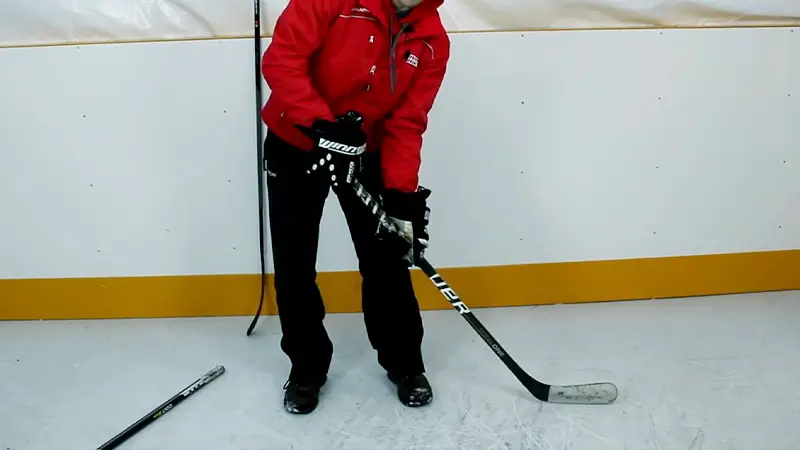The world of hockey has long held a fascination with the prevalence of left-handed players.
From the outside looking in, it may seem as though a disproportionate number of hockey stars favor their left hand when shooting or handling the puck.
But is this perception grounded in reality, or is it a myth that has endured over the years?
In this exploration, we’ll delve into the fascinating topic of why are most hockey players left-handed and uncover the truths and misconceptions that surround this phenomenon.
From stick design to shooting angles, we’ll examine the factors that contribute to the impression of left-handed dominance in hockey.
So, let’s lace up our skates and embark on a journey to demystify the world of left-handed hockey players. So, stay focused.

The Southpaw Prevalence in Hockey
In the world of hockey, southpaws or left-handed players are a less common sight compared to their right-handed counterparts.
While there is no precise statistic readily available, it is estimated that southpaw players make up a minority of the total hockey player population.
This imbalance is primarily due to the fact that hockey sticks are predominantly designed for right-handed players, and left-handed sticks are less common and can be harder to find.
Despite their relative rarity, left-handed hockey players bring a unique advantage to the game. Their shooting angle can catch goaltenders off-guard, and their playing style can add unpredictability to team strategies.
Southpaw players have certainly left their mark in the world of hockey, demonstrating that it’s not about quantity but quality when it comes to their impact on the ice.
Why Are Most Hockey Players Left Handed?
Most hockey players are not left-handed; in fact, the majority of hockey players are right-handed.
However, it might appear that there is a prevalence of left-handed players due to some misconceptions and factors in the sport.
Stick-Handling Bias
Hockey sticks are primarily designed for right-handed players. This means that left-handed sticks (commonly referred to as “lefty” sticks) are less common and can be harder to find.
As a result, some right-handed players may choose to shoot left-handed because it’s more convenient to find equipment.
Shooting Angle Advantage
Some players prefer to shoot left-handed because it offers a different shooting angle compared to right-handed shooting. This can catch goaltenders off-guard and potentially give them an advantage in certain situations.
Personal Preference
A player’s handedness in hockey often comes down to personal preference and what feels more natural to them.
Some players may naturally gravitate towards being left-handed even if they are right-handed in their daily lives.
While there may be a perception of more left-handed players in hockey due to the unique advantages they bring, it’s not accurate to say that most hockey players are left-handed. The majority are still right-handed shooters.
The ‘Lefty’ Stereotype in Hockey Culture
The “lefty” stereotype in hockey culture refers to certain assumptions and perceptions associated with left-handed players. This stereotype can include several elements:
Unpredictability
Left-handed players are often seen as unpredictable because their style of play and shooting angle differ from the majority of right-handed players.
This unpredictability can make them more challenging for goaltenders and defenders to read.
Creativity
Left-handed players are sometimes believed to be more creative on the ice. Their unique shooting angles and playing style can lead to innovative plays and scoring opportunities.
Advantageous Shooting
Left-handed players can have an advantage when shooting because they often catch goaltenders off-guard. The stereotype suggests that their shots are harder to stop due to the unusual angles they create.
Scarce Equipment
Left-handed sticks and equipment are less common, leading to the perception that left-handed players are somewhat unconventional or distinctive in their approach to the game.
It’s important to note that while these stereotypes exist, they don’t apply universally to all left-handed players, and many successful right-handed players also exhibit creativity and unpredictability in their gameplay.
Stereotypes can be limiting and should not be used to generalize or judge players based on their handedness.
Advantages of Being a Left-Handed Player

Being a left-handed player in hockey can offer several advantages, although it’s essential to remember that success in the sport depends on individual skills, dedication, and teamwork rather than handedness.
Nevertheless, here are some potential advantages that left-handed players may have:
Shooting Angle Surprise
Left-handed shooters can create different shooting angles compared to the majority of right-handed players.
This can catch goaltenders off-guard and increase the chances of scoring goals, particularly when shooting from certain positions on the ice.
Puck Control
Left-handed players may have an advantage in puck control and stickhandling, as their dominant hand (the left hand) is typically closer to the blade of the stick. This can provide them with better control when maneuvering the puck.
Offensive Versatility
Left-handed players can be versatile on the offensive side of the game. They can adapt to various situations, offering options like one-timers, backhand shots, and quick releases that can surprise opponents.
Passing and Playmaking
Left-handed players can excel in making accurate and unexpected passes, which can disrupt opposing defenses and create scoring opportunities for their teammates.
Defensive Advantage
In certain defensive situations, left-handed players can use their stick and body positioning to their advantage when protecting the puck or defending against opponents.
Faceoffs
Left-handed players may have an advantage in faceoffs, as they can use their dominant hand to gain better control of the puck during the drop.
It’s crucial to emphasize that while these advantages exist, they do not guarantee success in hockey. Skill development, teamwork, strategy, and dedication are equally essential factors in a player’s performance on the ice.
The Righties Breaking the Mold
In the world of hockey, right-handed players who break the mold are those who challenge the dominant stereotype that left-handed players possess a unique advantage.
These righties bring their own set of skills and attributes to the game, demonstrating that success in hockey isn’t solely determined by handedness.
Here are a few ways in which right-handed players break the mold:
Shooting Accuracy
Right-handed players often develop exceptional accuracy and precision in their shots. They can pick corners and execute pinpoint passes with their dominant right hand on the stick blade.
Adaptability
Right-handed players are adaptable and can excel in various positions on the ice. They are known for their ability to transition seamlessly between offensive and defensive roles.
Physicality
Some right-handed players are renowned for their physical play. They use their strength and body positioning to protect the puck, deliver powerful hits, and win board battles.
Playmaking Skills
Many right-handed players are exceptional playmakers. They possess excellent vision, hockey IQ, and passing abilities, setting up scoring opportunities for their teammates.
Faceoff Prowess
Right-handed players can be dominant in faceoff situations. They use their dominant hand to gain a significant advantage during puck drops, controlling possession for their team.
Leadership
Right-handed players often assume leadership roles on their teams. They lead by example, showcasing their work ethic, determination, and commitment to the game.
It’s important to recognize that success in hockey, as in any sport, is not determined by handedness but by a combination of individual skills, dedication, teamwork, and strategy.
Biological Factors Contributing to the Handedness of Hockey Players

The handedness of hockey players, whether left-handed or right-handed, is primarily influenced by biological factors, particularly the player’s dominant hand and eye.
Here are some key biological factors contributing to a player’s handedness in hockey:
Dominant Hand
One of the most significant biological factors is a player’s dominant hand. In most cases, a player’s dominant hand determines their stick-handling preference.
If a player’s dominant hand is their right hand, they are more likely to be a right-handed player, and if their dominant hand is their left hand, they are more likely to be a left-handed player.
Dominant Eye
Handedness in hockey is not solely about the hand but also the eye which provides better visual control. Players tend to use their dominant eye as their guide when aiming and shooting.
It’s common for players to align their dominant eye with their dominant hand, which can reinforce their handedness.
However, some players may use their non-dominant eye, which can lead to “cross-dominance” and result in a different handedness.
Brain Hemispheric Dominance
There is some evidence to suggest that handedness may be influenced by brain hemispheric dominance.
In right-handed individuals, the left hemisphere of the brain typically controls language and fine motor skills, which may align with right-handedness.
Conversely, left-handed individuals may have a more dominant right hemisphere, potentially influencing their handedness.
Genetics
There may be a genetic component to handedness. Research has indicated that handedness can run in families, suggesting that genetics play a role in determining a person’s dominant hand.
Early Motor Development
Early childhood experiences and motor development can also influence handedness.
Some children may naturally gravitate toward using one hand more than the other during early activities like writing or throwing, which can affect their handedness in sports like hockey.
It’s important to note that while these biological factors play a role in determining a player’s handedness, there is still a degree of individual variation, and not all left-handed players have the same dominant hand or eye.
FAQs
Why do many hockey players appear to be left-handed?
The perception that most hockey players are left-handed is due to the prevalence of “lefty” sticks. These sticks are designed for right-handed players, making left-handed sticks less common.
Consequently, some right-handed players choose left-handed sticks for convenience, creating the impression of more left-handed players.
Is there a strategic advantage to being a left-handed hockey player?
Left-handed players can have an advantage in creating unique shooting angles that can surprise goaltenders.
However, the advantage varies among players, and success in hockey depends on individual skills, teamwork, and dedication rather than handedness.
Are left-handed hockey players more skilled than right-handed players?
Handedness doesn’t determine a player’s skill level in hockey. Both left-handed and right-handed players can excel in the sport.
Success is influenced by factors like talent, training, and experience, rather than the hand they use to shoot.
Do left-handed hockey players have better stickhandling abilities?
Left-handed players may have an advantage in stickhandling because their dominant hand is closer to the stick blade.
However, stickhandling proficiency varies from player to player, and many right-handed players are exceptional at stickhandling as well.
Are there any statistics on the percentage of left-handed hockey players?
Precise statistics on the percentage of left-handed hockey players are not readily available. Handedness can vary by league, team, and region, making it challenging to determine an exact percentage.
However, most hockey players are still right-handed shooters, not left-handed.
Wrapping Up
In the world of hockey, the dominance of left-handed players is a perception that has persisted, but it’s important to clarify the reality.
While left-handed sticks and shooting angles may contribute to this perception, the truth is that hockey welcomes players of all handedness.
Success in this beloved sport is not determined by the hand a player uses to shoot but by their dedication, skill, and teamwork.
So, whether left-handed or right-handed, every player brings their unique abilities to the ice, enriching the game and keeping fans on the edge of their seats with every thrilling play.
In the end, it’s the love of the game that truly matters, regardless of which hand holds the stick. Thank you so much.







Benjamin Kenyon